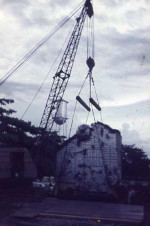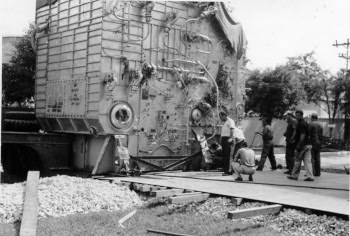Most people think of a boiler as a piece of oblong shaped equipment encased in a white enameled cover, usually located on the wall of the kitchen or inside a cupboard that heats the radiators and supplies hot water to the taps, but the boiler, hero of this true story, was the size of a semi detached house and weighed 50 tons.
Really large power station boilers can be the size of a tall apartment block and several I have been involved with were 11 stories high and maintenance personnel had to use a lift to get to the upper drum.
Our boiler was from the american battleship, USS Hawaii, built during the second world war, 85% finished, launched, but never commissioned, that is put into service, due to cutbacks after the war. Instead it was very well preserved or "put into mothballs" as the expression was in those days. After 20 years it was sold to Boston Metals, a scrapyard based in Baltimore, Maryland who specialised in ship-breaking. They buy a ship due to be scrapped, strip everything of value, pumps, doors portholes, all machinery including turbines and boilers. They then cut up the metal down to the water line, then tow the keel to a drydock to be cut up. Everything is for sale, the steel goes for scrap and the machinery is stored in their gigantic warehouse where buyers can browse. I know because I spent 6 weeks in that "Aladdins Cave" for power engineers.
The USS Hawaii had 8 identical boilers which could each produce one hundred thousands pounds per hour of steam at 600 pounds per square inch pressure using heavy fuel oil. The steam was used to drive turbines for electrical power and to drive the giant propellers.
I was working at Sudamtex, a synthetic textile company in Venezuela from December 1961. Sudamtex was a subsiduary of United Merchants and Manufacturers which was the third largest textile company in the USA at that time. It had been founded by Jack Schwab who was an immigrant and started selling cloth from a wheel-barrow in New York.
I had joined the company as an engineering graduate trainee and was working in the factory's power house, learning to operate the machinery and also how to speak spanish. Luckily none of the crew spoke english so I learnt fairly quickly. We had only one boiler and steam turbine at the time, but plans were afoot to expand the factory and also the power plant by adding two more boilers and turbines. There was not enough money available for new units so our chief group engineer, a Dane called Eric Nielsen went to America to buy the equipment. He went to Boston Metals and bought 3 of the Hawaii boilers complete with all auxiliary equipment, fans, pumps, valves etc for $25 thousand each which was a bargain even in those days. Even though the boilers were 'used' they had never actually been fired. Two of the boilers were for our Venezuelan plant and the other was for our plant in Uruguay. (At that time, the South American Division operated plants in Buenos Aires, Argentina; Colonia in Uruguay; Gavea, a suburb of Rio de Janiero in Brasil and ours at Maracay in Venezuela.) I was fortunate to spend time at all of these plants in the course of a 20 year career with Sudamtex.
The chief engineer, my boss, was Ricardo Contreras. He was a chilean who had studied engineering in the States. His father was a military officer and his mother was german. He was a strict disciplinarian, hard working, but thick headed as later events showed. He relied on his own judgment always and would not take advice.
When the boilers arrived at La Guaira, the Venezuela port on the coast directly north of Caracas, he went down with two low-boys (low slung lorries) to transport them to the plant, a journey of about 150 miles. The problem was that the boilers were 6 metres high and had to be brought through the main roads of Caracas, so they were accompanied by a squad of policemen, telephone and electrical workers to cut overhead cables and reconnect as the lowboys and their load passed along at 10 miles an hour or less. Everything went according to plan and they got through Caracas and onto the winding Pan-american highway which passed through Los Teques and on to the Motorway to Maracay. By this time it was early evening so Ricardo thinking that the worst was over, left them to get back to Maracay. After a days hard work, the drivers also wanted to get back home so they speeded up on the Panamericano, ignoring the fact that the road through the mountains, although wide enough, had bends which went up and down as well as on the horizontal. They also hadn't taken into account the fact that the boiler which weighed 50 tons had its centre of gravity high up. So at one bend, as the lorry pulled out of the downhill curve, the boiler carried straight on and the whole rig capsized.
.jpg)
.jpg)
.jpg)
Luckily the boiler was not damaged, but it took about 15 days to lift back up and get to the plant. The other boiler had not gone over and arrived safely at the plant the day after the accident.
.jpg)
The next job was to move the boilers from the low-boys on to the concrete plinths which we had already prepared. Jose Bendicho, Ricardo's assistant in charge of the mechanical workshops, who was from Barcelona, Spain and had experience in moving heavy machinery, had suggested to Ricardo, that with a little preparation, the boilers could be slid off the low-boys using heavy I-beams as rails and with block and tackle to pull. Ricardo knew best though and insisted on hiring a crane as it would be quicker. Unfortunately the only crane available was old and 50 tons was its limit of capacity.
A couple of days was spent trying to make the lift, but the crane would only tip up, so concrete blocks were put on to the rear end of the crane. The whole thing was turning into a pantomime as Ricardo would still not admit that Bendicho's idea was safer and better, until finally the boom of the crane snapped in two. Unfortunately the steel hawsers supporting the boom whipped down under the release of tension and hit Ricardo on the foot and smashed his ankle. Why was he standing so close to the crane?? You have to know him to be able to answer that.



Ricardo of course was out of action finally and he needed several operations until back at work 6 months later.
Bendicho's method was adopted and both boilers were placed on their bases safely.
I was still only a trainee at the time and was keeping the power plant going, but I was watching and learning so that when it was my turn to repeat the operation in Brasil I was sure not to make the same mistakes.
As we were without a chief engineer, Desmond Murphy, an anglo-argentine, who was chief engineer at our Buenos Aires plant came up to take over the helm. He was completely different from Ricardo and allowed me a free hand to continue with the running of the power house and installation of the new boilers. He actively encouraged me to take decisions. Ricardo's authoritarian style meant that he had to approve everything and his idea prevailed. It was a great training for me and for the first time in my career I felt satisfied.
After 6 months Desmond went back home and Ricardo came back with the same style. There was one more incident when he installed some High Tension cables his way instead of following the advice of a consultant electrical engineer. There was an almighty short circuit that shut the plant down for a couple of days. With this he lost the support of the Plant Manager and his contract was terminated.
Another of the Hawaii boilers was purchased for a new textile plant being built at Teresopolis, a beautiful mountain village to the north of Rio de Janeiro in Brasil. I was assigned the job of getting this boiler from Baltimore to Teresopolis. I would then stay there to act as advisor in the installation of their new power plant.